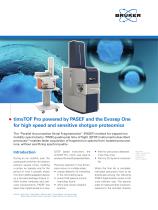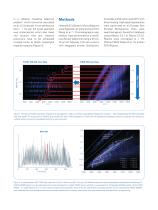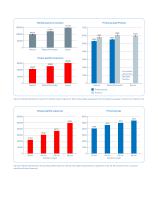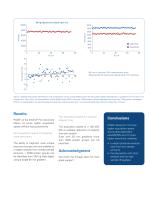
Catalog excerpts

timsTOF Pro powered by PASEF and the Evosep One for high speed and sensitive shotgun proteomics The “Parallel Accumulation Serial Fragmentation” (PASEF) method for trapped ion mobility spectrometry (TIMS) quadrupole time of flight (QTOF) instruments described previously [1] enables faster acquisition of fragment ion spectra from isolated precursor ions, without sacrificing spectral quality. Introduction During an ion mobility scan the quadrupole switches its isolation position several times, isolating a certain ion species only for the period of time it actually elutes from the mobility separation device as a focused package (Figure 1). With further hardware and software improvements, PASEF has been fully implemented on a new QTOF based instrument, the timsTOF Pro, which was used to produce the results presented here. Precursor selection in two dimensions occurs in multiple steps: • coarse detection of intensities in the mz/mobility pane • extract MS spectra around intensities found • refine and correct isolation position Authors: Heiner Koch 1, Scarlet Beck 1, Markus Lubeck 1, Oliver Raether 1 and Gary Kruppa 2. 1 Bruker Daltonik GmbH, Bremen, Germany; 2 Bruker Daltonics Inc, Billerica, USA • filter for precursors detected more than once • filter by 2D dynamic exclusion list When the final list is compiled, individual precursors have to be distributed among the following PASEF fragmentation scans in the most efficient way. The optimal order of measurements would correspond to the shortest itinerary Keywords: PASEF, timsTOF Pro, TIMS, clinical
Open the catalog to page 1
in a classical 'travelling salesman problem' which cannot be calculated on an LC timescale. A non-perfect but fast (~ 1 ms per full cycle) approach was implemented which also takes into account that low intensity precursors have to be scheduled multiple times to obtain meaningful fragment spectra (Figure 2). Methods Hela cells (CIL Biotech, Mons, Belgium) were digested using the protocol from Wang et al. [ 2]. Chromatographic separations were performed on a nanoE-lute (Bruker Daltonics) using a 25 cm, 75 pm ID Odyssey C18 nano column with integrated emitter (lonOpticks, Australia) at 400...
Open the catalog to page 2
Number of precursor ions fragmented per PASEF scan 12000 12000 Number of precursor ions fragmented per PASEF frame Figure 3: Distribution of the number of precursor ions fragmented per PASEF MS/MS scan during a 90 min LC autoMS/MS gradient (200 ng HeLa digest). On average 12.6 precursors are addressed during a 100 ms PASEF scan, resulting in > 100 Hz acquisition speed. However, due to the 100 ms accumulation time, the signal intensity per fragment spectrum is still comparable to a 10 Hz acquisition. Number of repetitive measurements per precursor 100000 100000 2 3 4 5 6 7 8 9 10 Figure 4:...
Open the catalog to page 3
Mascot Mascot Mascot/Percolator Mascot/Percolator Byonic Byonic Unique peptide sequences 60160 Figure 5: Peptide identification results from different search engines for 200 ng HeLa digest separated by 90 min gradients (average numbers from triplicate runs). Mascot Mascot 0 Unique peptide sequences Mascot/Percolator Mascot/Percolator Protein groups Byonic Byonic Gradient length Gradient length Figure 6: Peptide identification results (Mascot/Percolator) for 200 ng HeLa digest separated by LC gradients of 30, 45, 60 and 90 minutes, using the nanoElute (Bruker Daltonics).
Open the catalog to page 4
# PSMs # PSMs # PSMs # PSMs # Proteins # Proteins # Proteins # Proteins # Proteins # Proteins Identified Identified Identified Identified Quantified Quantified Quantified Quantified 20 80 runs in less than 10h measurement time! Reproducible ID results and reproducible TIC intensities. Figure 7: Peptide and protein identification and quantification results (using PEAKS studio) for 50 ng HeLa digest separated by LC gradients of 5 minutes on an Evosep One. Even with a 5 minute gradient, almost 8000 unique PSM’s, and over 1400 proteins could be identified with more than 1000 proteins...
Open the catalog to page 5
Learn More You are looking for further Information? Check out the link or scan the QR code. For research use only. Not for use in diagnostic procedures. Bruker Daltonik GmbH Bremen · Germany Phone +49 (0)421-2205-0 Fax +49 (0)421-2205-103 ms.sales.bdal@bruker.com – www.bruker.com to change specifications without notice. © Bruker Daltonics 04-2018, PN-52 [1] Meier et al, J Proteome Res.,2015; 14(12); 5378-87 [2] Wang et al, J Proteome Res., 2005; 4(6); 2397-2403 Bruker Daltonics is continually improving its products and reserves the right
Open the catalog to page 6All Bruker Daltonics Inc. catalogs and technical brochures
-
Label-Free Molecular Imaging
12 Pages
-
MALDI Biotyper® CA System
12 Pages
-
IntelliSlidesTM
2 Pages
-
CMC-assist
2 Pages
-
Toxtyper
8 Pages
-
Product Overview
16 Pages
-
spotOn™
4 Pages
-
Metabolomics
8 Pages
-
BioPharma Compass® 2.0
8 Pages
-
TASQ Software
4 Pages
-
timsTOF™
8 Pages
-
TargetScreener
6 Pages
-
Quant Proteomics
8 Pages
-
MBT Galaxy RUO
4 Pages
-
MBT Pilot RUO
4 Pages
-
MBT SMART IVD
4 Pages
-
MBT Consumables RUO
4 Pages
-
MBT Sepsityper
6 Pages
-
MBT BTS US
2 Pages
-
MBT Disposable Targets US
2 Pages
-
MBT Pharma
8 Pages
-
MALDI Imaging
16 Pages
-
rapifleX™ MALDI Tissuetyper™
8 Pages
-
PesticideScreener 2.0
8 Pages
-
MBT Mycobacteria Library
4 Pages
-
MALDI Biotyper Clinical IVD
6 Pages
-
MALDI Biotyper CA System
12 Pages
-
Bruker ToxScreener
6 Pages
-
ProteinScape
8 Pages
-
maxis II
12 Pages
-
EVOQ
6 Pages
-
impact II
12 Pages
-
micrOTOF II
8 Pages
-
ImagePrep
4 Pages
-
DE-tector
6 Pages
-
pTD
2 Pages
-
RAID AFM
4 Pages
-
RAID XP
4 Pages
-
RAID S2
6 Pages
-
RAID M100
6 Pages
-
MM2
6 Pages
-
SVG 2 and Probes
6 Pages
-
µRAID
4 Pages
-
VeroTect
4 Pages
-
SIGIS II
2 Pages
-
solarix XR
12 Pages
-
The new autoflex speed
10 Pages
-
Product Overview
20 Pages
-
impact HD
12 Pages
-
Radiation Backpack Sentry
4 Pages
-
Toxtyper
6 Pages
-
micrOTOF-Q III
6 Pages
Archived catalogs
-
EVOQ - 2014
6 Pages

































































